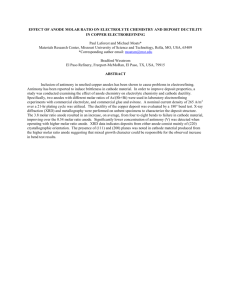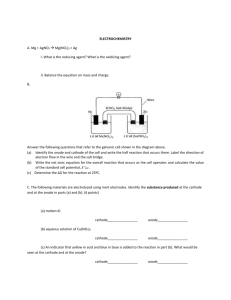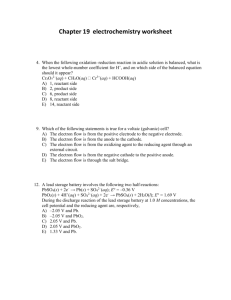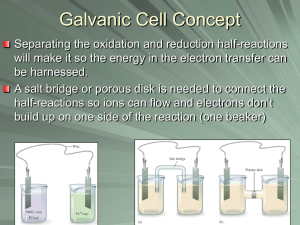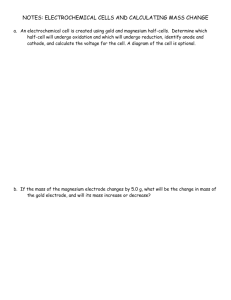Electrochemistry
advertisement
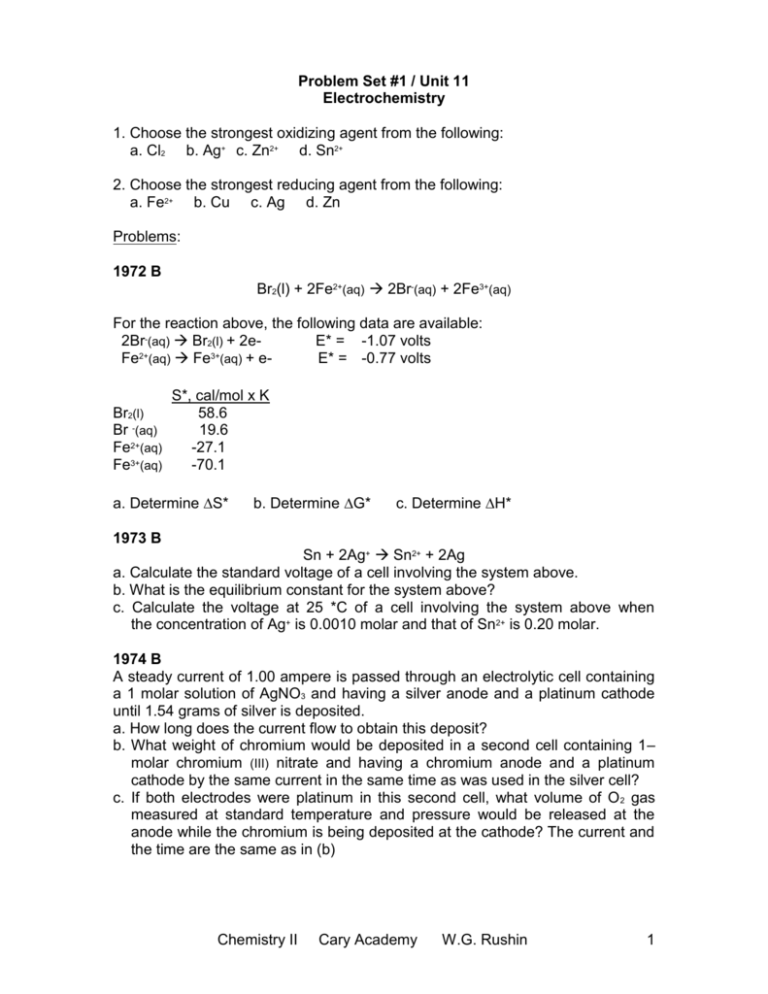
Problem Set #1 / Unit 11 Electrochemistry 1. Choose the strongest oxidizing agent from the following: a. Cl2 b. Ag+ c. Zn2+ d. Sn2+ 2. Choose the strongest reducing agent from the following: a. Fe2+ b. Cu c. Ag d. Zn Problems: 1972 B Br2(l) + 2Fe2+(aq) 2Br-(aq) + 2Fe3+(aq) For the reaction above, the following data are available: 2Br-(aq) Br2(l) + 2eE* = -1.07 volts 2+ 3+ Fe (aq) Fe (aq) + eE* = -0.77 volts S*, cal/mol x K Br2(l) 58.6 Br -(aq) 19.6 2+ Fe (aq) -27.1 Fe3+(aq) -70.1 a. Determine S* b. Determine G* c. Determine H* 1973 B Sn + 2Ag+ Sn2+ + 2Ag a. Calculate the standard voltage of a cell involving the system above. b. What is the equilibrium constant for the system above? c. Calculate the voltage at 25 *C of a cell involving the system above when the concentration of Ag+ is 0.0010 molar and that of Sn2+ is 0.20 molar. 1974 B A steady current of 1.00 ampere is passed through an electrolytic cell containing a 1 molar solution of AgNO3 and having a silver anode and a platinum cathode until 1.54 grams of silver is deposited. a. How long does the current flow to obtain this deposit? b. What weight of chromium would be deposited in a second cell containing 1– molar chromium (III) nitrate and having a chromium anode and a platinum cathode by the same current in the same time as was used in the silver cell? c. If both electrodes were platinum in this second cell, what volume of O 2 gas measured at standard temperature and pressure would be released at the anode while the chromium is being deposited at the cathode? The current and the time are the same as in (b) Chemistry II Cary Academy W.G. Rushin 1 1976 B a. Calculate the value of G* for the standard cell reaction Zn + Cu2+(1M) Zn2+(1M) + Cu b. One half cell of an electrochemical cell is made by placing a strip of pure zinc in 500 milliliters of 0.10 molar ZnCl2 solution. The other half cell is made by placing a strip of pure copper in 500 milliliters of 0.010 molar Cu(NO 3)2 solution. Calculate the initial voltage of this cell when the two half cells are joined by a salt bridge and the two metal strips are joined by a wire. c. Calculate the final concentration of copper ion, Cu2+, in the cell described in part (b) if the cell were allowed to produce an average current of 1.0 ampere for 3 minutes 13 seconds. 1980 B M(s) + Cu2+(aq) M2+(aq) + Cu(s) For the reaction above E* = 0.740 volt at 25 *C a. Determine the standard electrode potential for the reduction half reaction: M2+(aq) + 2e- M(s) b. A cell is constructed in which the reaction above occurs. All substances are initially in their standard states, and equal volumes of the solutions are used. The cell is then discharged. Calculate the value of the cell potential E, when [Cu2+] has dropped to 0.20 molar. c. Find the ratio [M2+]aq/[Cu2+]aq when the cell reaction above reaches equilibrium. 1982 B When a dilute solution of H2SO4 is electrolyzed, oxygen gas is produced at the anode and hydrogen gas is produced at the cathode. a. Write the balanced equations for the anode, cathode, and overall reactions that occur in this cell. b. Compute the coulombs of charge passed through the cell in 100. minutes at 10.0 amperes. c. What number of moles of O2 is produced by the cell when it is operated for 100. minutes at 10.0 amperes? 1985 B a. Titanium can be reduced in acid solution from TiO2+ to Ti3+ with zinc metal. Write a balanced equation for the reaction of TiO2+ with zinc in acid solution. b. What mass of zinc metal is required for the reduction of a 50.00 mL sample of a 0.115 M solution of TiO2+. c. Alternatively, the reduction of TiO2+ to Ti3+ can be carried out electrochemically. What is the minimum time, in seconds, required to reduce another 50.00 mL sample of the 0.115 M TiO2+ solution with a direct current of 1.06 amperes? d. The standard reduction potential, E*, for TiO2+ to Ti3+ is +0.060 volt. The standard reduction potential, E*, for Zn2+ to Zn(s) is -0.763 volt. Calculate the standard cell potential, E*, and the standard free energy change, G*, for the reaction described in part (a). Chemistry II Cary Academy W.G. Rushin 2 1986 B A direct current of 0.125 A was passed through 200 mL of a 0.25 M solution of Fe2(SO4)3 between platinum electrodes for a period of 1.100 hours. Oxygen gas was produced at the anode. The only change at the cathode was a slight change in the color of the solution. At the end of the electrolysis, the electrolyte was acidified with sulfuric acid and was titrated with an solution of KMnO4. The volume of KMnO4 solution required to reach the endpoint was 24.65 mL. a. How many faradays were passed through the solution? b. Write a balanced half-reaction for the process that occurred at the cathode during the electrolysis. c. Write a balanced net ionic equation for the reaction that occurred during the titration with KMnO4. d. Calculate the molarity of the KMnO4 solution. 1988 B An electrochemical cell consists of a tin electrode in an acidic solution of 1.00 molar Sn2+ connected by a salt bridge to a second compartment with a silver electrode in an acidic solution of 1.00 molar Ag+. a. Write the equation for the half–cell reaction occurring at each electrode. Indicate which half–reaction occurs at the anode. b. Write the balanced chemical equation for the overall spontaneous cell reaction that occurs when the circuit is complete. Calculate the standard voltage, E*, for this cell reaction. c. Calculate the equilibrium constant for this cell reaction at 298K. d. A cell similar to the one described above is constructed with solutions that have initial concentrations of 1.00 molar Sn2+ and 0.0200 molar Ag+. Calculate the initial voltage, E, of this cell. 1989 B The electrolysis of a aqueous solution of potassium iodide, KI, results in the formation of hydrogen gas at the cathode and iodine at the anode. A sample of 80.0 mL of a 0.150 M solution of KI was electrolyzed for 3.00 min., using a constant current. At the end of this time, the I2 produced was titrated against a 0.225 M solution of sodium thiosulfate, which reacts with iodine according to the equation below. The endpoint of the titration was reached when 37.3 mL of the Na2S2O3 solution had been added. I2(s) + 2S2O32-(aq) 2I-(aq) + S4O62-(aq) a. How many moles of I2 were produced during the electrolysis? b. The hydrogen gas produced at the cathode during the electrolysis was collected over water at 25 *C at a total pressure of 752 mm of Hg. Determine the volume of hydrogen collected. The vapor pressure of water at 25 *C is 24 mm Hg. c. Write the equation for the half-reaction that occurs at the anode during the electrolysis. d. Calculate the current used during the electrolysis. Chemistry II Cary Academy W.G. Rushin 3 1992 B An unknown metal M forms a soluble compound, M(NO3)2. a. A solution of M(NO3)2 is electrolyzed. When a constant current of 2.50 amperes is applied for 35.0 minutes, 3.06 grams of the metal M is deposited. Calculate the molar mass of M and identify the metal. b. The metal identified in (a) is used with zinc to construct a galvanic cell, as shown below. Write the net ionic equation for the cell reaction and calculate the cell potential, E*. K + Cl - Metal M Zinc 1.0 M M(NO ) 3 2 1.0 M Zn SO 4 c. Calculate the value of the standard free energy change, G*, at 25 *C for the reaction in (b). d. Calculate the potential, E, for the cell shown in (b) if the initial concentration of ZnSO4 is 0.10-molar, but the concentration of the M(NO3)2 solution remains unchanged. In Other Words: 1. Sketch an electrolysis cell in which the net cell reaction is ______ : a. Identify the anode and cathode. b. Write the half-reactions that occur at each electrode. c. Indicate the direction of ion flow. d. Indicate the direction of electron flow in the external circuit. 2. Sketch a galvanic cell in which the net cell reaction is ______ : a. Identify the anode and cathode. b. Write the half-reactions that occur at each electrode. c. Indicate the direction of the flow of ions from the salt bridge. d. Indicate the direction of electron flow in the external circuit. e. Write the cell diagram. 1981 D A solution of CuSO4 was electrolyzed using platinum electrodes by passing a current through the solution. As a result, there was a decrease in both [Cu2+] and the solution pH; one electrode gained in weight a gas was evolved at the other electrode. a. Write the cathode half reaction that is consistent with the observations above. b. Write the anode half reaction that is consistent with the observations above. c. Sketch an apparatus that can be used for such an experiment and label its necessary components. d. List the experimental measurements that would be needed in order to determine from such an experiment the value of the faraday. Chemistry II Cary Academy W.G. Rushin 4 1987 D A dilute solution of sodium sulfate, Na2SO4, was electrolyzed using inert platinum electrodes. In a separate experiment, a concentrated solution of sodium chloride, NaCl, was electrolyzed also using inert platinum electrodes. In each experiment, gas formation was observed at both electrodes. a. Explain why metallic sodium is not formed in either experiment. b. Write balanced equations for the half–reactions that occur at the electrodes during electrolysis of the dilute sodium sulfate solution. Clearly indicate which half–reaction occurs at each electrode. c. Write balanced equations for the half–reactions that occur at the electrodes during electrolysis of the concentrated sodium chloride solution. Clearly indicate which half–reaction occurs at each electrode. d. Select two of the gases obtained in these experiments, and for each gas, indicate one experimental procedure that can be used to identify it. 1991 D Explain each of the following. a. When an aqueous solution of NaCl is electrolyzed, Cl2(g) is produced at the anode, but no Na(s) is produced at the cathode. b. The mass of Fe(s) produced when 1 faraday is used to reduce a solution of FeSO4 is 1.5 times the mass of Fe(s) produced when 1 faraday is used to reduce a solution of FeCl3. c. Zn + Pb2+ (1–molar) ---> Zn2+ (1–molar) + Pb The cell that utilizes the reaction above has a higher potential when [Zn 2+] is decreased and [Pb2+] is held constant, but a lower potential when [Pb 2+] is decreased and [Zn2+] is held constant. d. The cell that utilizes the reaction given in (c) has the same cell potential as another cell in which [Zn2+] and [Pb2+] are each 0.1–molar. Answers: 1980B a. E* = -0.40 V b. Ecell = 0.712 V 1982 B a. 2H2O + 2e- H2 + 2OH6H2O O2 + 4H3O+ + 4e2H2O 2H2 + O2 c. [M2+]/[Cu2+] = 1 x 1025 b. 6.00 x 104 c c. 0.155 mol O2 1986 B a. 5.13 x 10-3 F b. Fe3+ + e- Fe2+ d. 0.0416 M KMnO4 2+ + 2+ 3+ c. MnO4 + 5Fe + 8H3O Mn + 5Fe + 12H2O 1988 B a. Sn Sn2+ + 2e- (anode) Ag+ + e- Ag (cathode) b. 2Ag+ + Sn 2Ag + Sn2+ E*cell = 0.94 V 31 c. K = 6 x 10 d. Ecell = 0.84 V 1989 B a. 4.20 x 10-3 mol I2 b. 0.107 L H2 Chemistry II c. 2I- I2 + 2e- Cary Academy d. 4.50 A W.G. Rushin 5
